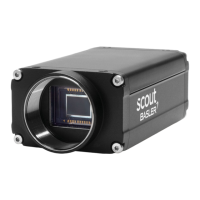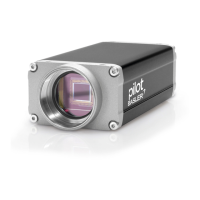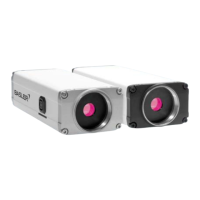Camera Functional Description AW00089317000
52 Basler ace GigE
4.3 Overview Rolling Shutter with CMOS
Sensor
Valid for
acA1280-60, acA1300-60, acA1600-60, acA1920-25, acA2500-14
The camera provides features such as an electronic rolling shutter and electronic exposure time
control.
Exposure start and exposure time can be controlled
by parameters transmitted to the camera via the Basler pylon API and the GigE interface.
There are also parameters available to set the camera for single frame acquisition or
continuous frame acquisition.
via an externally generated "frame start trigger" (ExFSTrig) signal applied to the camera’s input
line. The ExFSTrig signal facilitates periodic or non-periodic frame acquisition start.
Because the camera has a rolling shutter, the exposure start signal will only start exposure of the
first row of pixels in the sensor. Exposure of each subsequent row will then automatically begin with
an increasing temporal shift for each row. The exposure time will be equal for each row.
Accumulated charges are read out of each sensor when exposure ends. At readout, accumulated
charges are transported from the row’s light-sensitive elements (pixels) to the analog processing
controls (see Figure 34 on page 53). As the charges move through the analog controls, they are
converted to voltages proportional to the size of each charge. Each voltage is then amplified by a
Variable Gain Control (VGC). Next the voltages are digitized by an Analog-to-Digital converter
(ADC). After the voltages have been amplified and digitized, they are passed through the sensor’s
digital controls for additional signal processing. The digitized pixel data leaves the sensor, passes
through an FPGA, and moves into an image buffer.
The pixel data leaves the image buffer and passes back through the FPGA to an Ethernet controller
where it is assembled into data packets. The packets are then transmitted via an Ethernet network
to a network adapter in the host PC. The Ethernet controller also handles transmission and receipt
of control data such as changes to the camera’s parameters.
The image buffer between the sensor and the Ethernet controller allows data to be read out of the
sensor at a rate that is independent of the data transmission rate between the camera and the host
computer. This ensures that the data transmission rate has no influence on image quality.
Note
The camera models mentioned above have a switchable shutter mode. For
information, see Section 4.4 on page 54 and Section 7.7 on page 118.

